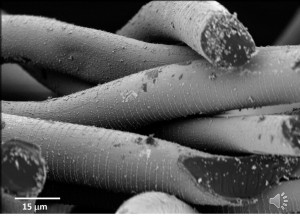
Technology currently under research pursues low-power energy harvesting from the human body—and textiles will have an important role to play.
Digital/electronic advancement has changed our culture into one that requires more information with less hassle and more privacy. Wearable electronics are playing a key role in the Internet of Things (IoT) as a platform for collecting and relaying personal information, using smartphone technology to route this information to the data cloud. The potential is astounding; in particular, improved personal wellness has the opportunity to alter the course of healthcare and related policies. Textiles are playing a critical role in this development.
One example is research being conducted at a National Science Foundation-funded engineering research center entitled ASSIST (Advanced Self Powered Systems of Integrated Sensors and Technologies), which is tasked to develop a new generation of wearable electronics for health (i.e. biopotential and biochemical) and environmental (i.e. gas and particulate) monitoring. ASSIST involves a multi-disciplinary and multi-university team, led by North Carolina State University (NCSU), which is focused on using advances in nanotechnology to construct ultra low-power electronics sensing systems that operate entirely on the power generated by the human body. As a part of this center, the College of Textiles is playing a leading role in device integration into wearables, including textiles-based patches and garments.

A human energy map
Specifically, my research group (in the Department of Textile Engineering, Chemistry & Science at NCSU) is exploring energy harvesting opportunities from the human body, in essence creating an energy map. Once the amount of harvested power at a location is determined, then this can be compared to what can be sensed at that location (physiologically or environmentally). The combination of these two will lead to self-powered wearable devices.
Our research includes not only materials modifications that enable more efficient energy harvesting, but design of electronic systems that complements the on-body analysis of energy harvesters. These system designs, being developed by Dr. Ryan Hodges, a postdoctoral researcher at NCSU, provide wireless transmission of energy harvesting performance such that population studies can be performed in real-life scenarios.
Of particular interest is the ability to harness thermal energy from the body. In general, the human body can provide ~100 W of power in the form of human heat. Given Carnot efficiencies, only about 10 percent of this heat is reasonable to harvest. Due to cost and comfort, it is also unlikely to consider harvesting all of this heat. However, a few hundred microwatts to a few milliwatts are capable by choosing strategic locations around pulse points, or locations where blood vessels are close to the skin surface.
The devices employed to harvest this power are referred to as thermoelectric generators (TEGs). TEGs use the Seebeck effect to generate electricity from a temperature gradient. To generate more power, multiple junctions of two thermoelectric materials with Seebeck coefficients of opposite sign are connected electrically in series and thermally in parallel. These devices, usually in the size range of ~1-10 cm2, are typically designed for applications in which temperature gradient is often a few hundred degrees. On the human body, this temperature difference (skin-to-atmosphere) is only a few degrees, making the conversion efficiency of these devices very low.
The material surrounding and encasing the TEG requires strategic design to harness the maximum amount of power. Currently, textiles play a critical role in conforming the devices to the body and providing the thermal insulation to maintain a temperature difference. In addition, advancements in filler content in synthetic fibers and inorganic surface coatings are allowing for improved thermal heat sink (air side) and spreader (skin side) thermal transport. These features enable a small TEG to harness power from a larger area on the body and maintain cooling.

The scope of waste heat recovery
The role of textiles in thermal energy harvesting goes beyond on-body applications. In collaboration with Dr. Mark Losego (Materials Science and Engineering; Georgia Institute of Technology) and Dr. Raju Ankireddy (a postdoctoral researcher at NCSU), we are developing thermal insulation with integrated thermoelectric devices that are printed into the insulation.
This research is supported through a Chancellor’s Innovation Fund grant from NCSU. According to the Department of Energy, waste heat costs U.S. industries more than $200 billion per year, accounting for more than 50 percent of the energy consumption in the U.S. Of this, 95 percent is lost at temperatures below 250°C and is most often spread out over large areas. Capturing even a small fraction of this heat and converting it to useful energy represents a significant market opportunity. The economics for harvesting this power require a technology that can be produced in large areas at a very inexpensive cost (less than $5 per W).
In waste heat recovery, textiles serve as an insulation platform for maintaining a temperature difference for TEGs junctions, as well as a potential platform for printing the thermoelectric materials. We are working to improve the printing density and reduce overall cost of materials. When applied, opportunities exist for battery-free IoT sensing of infrastructure to powering LED lighting.
 TEXTILES.ORG
TEXTILES.ORG


